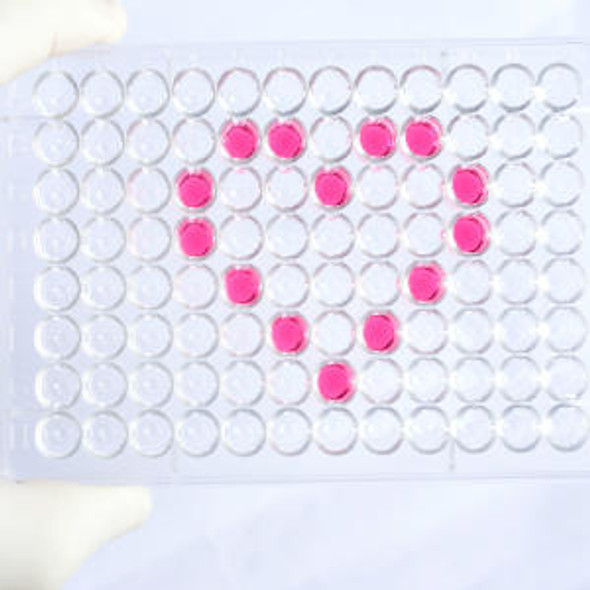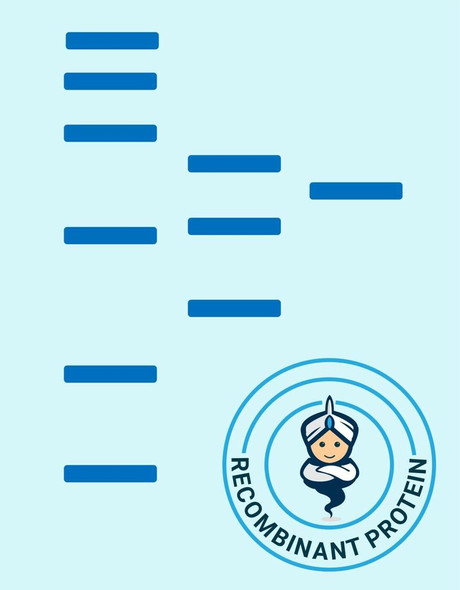Description
| Product Name: | Human PLAUR Recombinant Protein |
| Product Code: | RPPB4256 |
| Size: | 10µg |
| Species: | Human |
| Target: | PLAUR |
| Synonyms: | PLAUR, Monocyte Activation Antigen Mo3, U-PAR, UPAR, U-Plasminogen Activator Receptor Form 2, CD87 Antigen , CD87, URKR, MO3. |
| Source: | Sf9 Insect cells |
| Physical Appearance: | Sterile Filtered colorless solution. |
| Formulation: | PLAUR protein solution (0.5mg/ml) contains Phosphate Buffered Saline (pH 7.4) and 10% glycerol. |
| Stability: | Store at 4°C if entire vial will be used within 2-4 weeks. Store, frozen at -20°C for longer periods of time. For long term storage it is recommended to add a carrier protein (0.1% HSA or BSA).Avoid multiple freeze-thaw cycles. |
| Purity: | Greaterthan 95.0% as determined by SDS-PAGE. |
| Amino Acid Sequence: | LRCMQCKTNG DCRVEECALG QDLCRTTIVR LWEEGEELEL VEKSCTHSEKTNRTLSYRTG LKITSLTEVV CGLDLCNQGN SGRAVTYSRS RYLECISCGS SDMSCERGRH QSLQCRSPEEQCLDVVTHWI QEGEEGRPKD DRHLRGCGYL PGCPGSNGFH NNDTFHFLKC CNTTKCNEGP ILELENLPQN GRQCYSCKGNSTHGCSSEET FLIDCRGPMN QCLVATGTHE PKNQSYMVRG CATASMCQHA HLGDAFSMNH IDVSCCTKSG CNHPDLDVQYRSGLEHHHHH H |
PLAUR is one of 2 activators which convert the extracellular zymogen plasminogen to plasmin, a serine protease involved in a various normal and pathological processes that require cell migration and/or tissue destruction. PLAUR protein is synthesized and released from cells as a single-chain proenzyme with narrow enzymatic activity and is converted to an active two-chain disulfide-linked active enzyme by plasmin and other specific proteinases.
PLAUR produced in Sf9 Baculovirus cells is a single, glycosylated polypeptide chain containing 291 amino acids (23-305 a.a.) and having a molecular mass of 32.5kDa (Molecular size on SDS-PAGE will appear at approximately 40-57 kDa).PLAUR is fused to a�8 amino acid His-tag at C-terminus & purified by proprietary chromatographic techniques.
| UniProt Protein Function: | uPAR: Acts as a receptor for urokinase plasminogen activator. Plays a role in localizing and promoting plasmin formation. Mediates the proteolysis-independent signal transduction activation effects of U-PA. It is subject to negative-feedback regulation by U-PA which cleaves it into an inactive form. Monomer (Probable). Interacts with MRC2. Interacts (via the UPAR/Ly6 domains) with SRPX2. Expressed in neurons of the rolandic area of the brain. Expressed in the brain. 3 isoforms of the human protein are produced by alternative splicing. |
| UniProt Protein Details: | Protein type:Motility/polarity/chemotaxis; Receptor, misc.; Membrane protein, GPI anchor Chromosomal Location of Human Ortholog: 19q13 Cellular Component: endoplasmic reticulum membrane; focal adhesion; extrinsic to membrane; integral to plasma membrane; endoplasmic reticulum lumen; plasma membrane; integral to membrane Molecular Function:protein domain specific binding; protein binding; enzyme binding; U-plasminogen activator receptor activity; receptor activity; receptor binding Biological Process: fibrinolysis; cellular protein metabolic process; regulation of proteolysis; attachment of GPI anchor to protein; C-terminal protein lipidation; post-translational protein modification; cell motility; chemotaxis; signal transduction; blood coagulation |
| NCBI Summary: | This gene encodes the receptor for urokinase plasminogen activator and, given its role in localizing and promoting plasmin formation, likely influences many normal and pathological processes related to cell-surface plasminogen activation and localized degradation of the extracellular matrix. It binds both the proprotein and mature forms of urokinase plasminogen activator and permits the activation of the receptor-bound pro-enzyme by plasmin. The protein lacks transmembrane or cytoplasmic domains and may be anchored to the plasma membrane by a glycosyl-phosphatidylinositol (GPI) moiety following cleavage of the nascent polypeptide near its carboxy-terminus. However, a soluble protein is also produced in some cell types. Alternative splicing results in multiple transcript variants encoding different isoforms. The proprotein experiences several post-translational cleavage reactions that have not yet been fully defined. [provided by RefSeq, Jul 2008] |
| UniProt Code: | Q03405 |
| NCBI GenInfo Identifier: | 465003 |
| NCBI Gene ID: | 5329 |
| NCBI Accession: | Q03405.1 |
| UniProt Secondary Accession: | Q03405,Q12876, Q15845, Q16887, Q6IB52, Q9BWT0, Q9NYC8 Q9UD69, Q9UEA6, Q9UM92, Q9UMV0, A8K409, |
| UniProt Related Accession: | Q03405 |
| Molecular Weight: | 32,016 Da |
| NCBI Full Name: | Urokinase plasminogen activator surface receptor |
| NCBI Synonym Full Names: | plasminogen activator, urokinase receptor |
| NCBI Official Symbol: | PLAUR�� |
| NCBI Official Synonym Symbols: | CD87; UPAR; URKR; U-PAR�� |
| NCBI Protein Information: | urokinase plasminogen activator surface receptor; monocyte activation antigen Mo3; u-plasminogen activator receptor form 2; urokinase-type plasminogen activator (uPA) receptor |
| UniProt Protein Name: | Urokinase plasminogen activator surface receptor |
| UniProt Synonym Protein Names: | Monocyte activation antigen Mo3; CD_antigen: CD87 |
| Protein Family: | Urokinase plasminogen activator surface receptor |
| UniProt Gene Name: | PLAUR�� |
| UniProt Entry Name: | UPAR_HUMAN |






